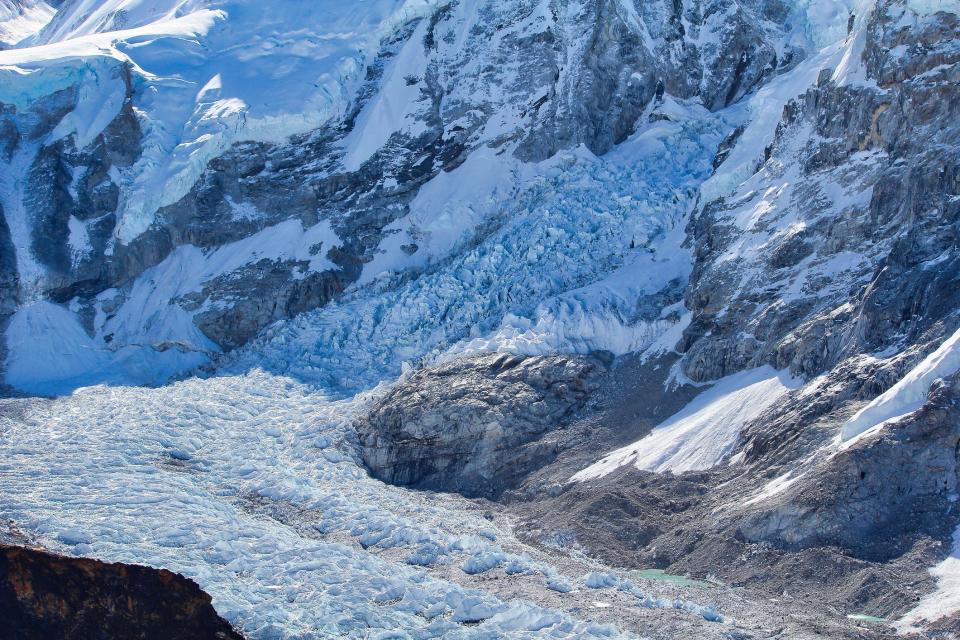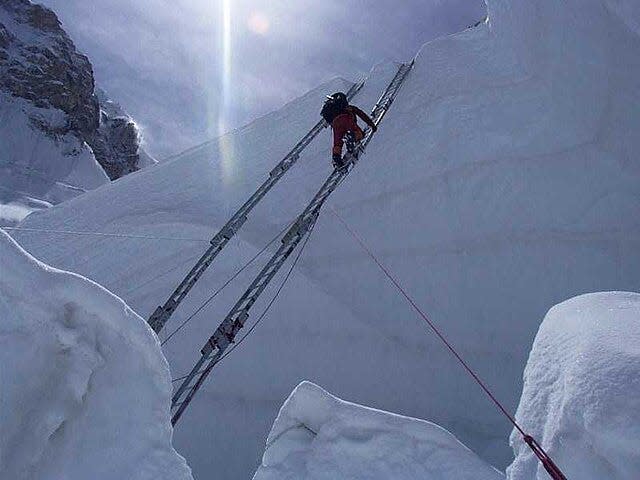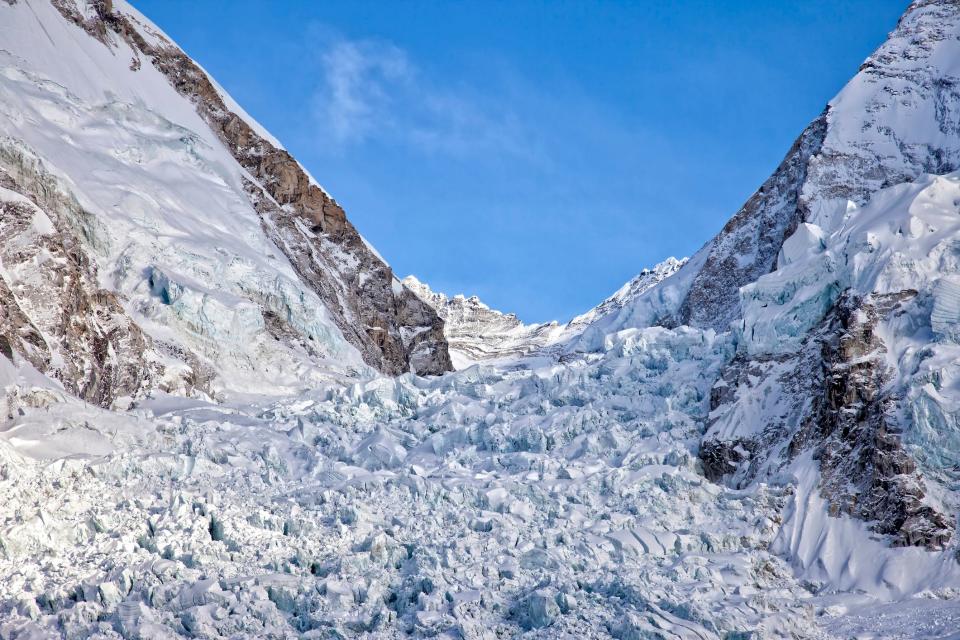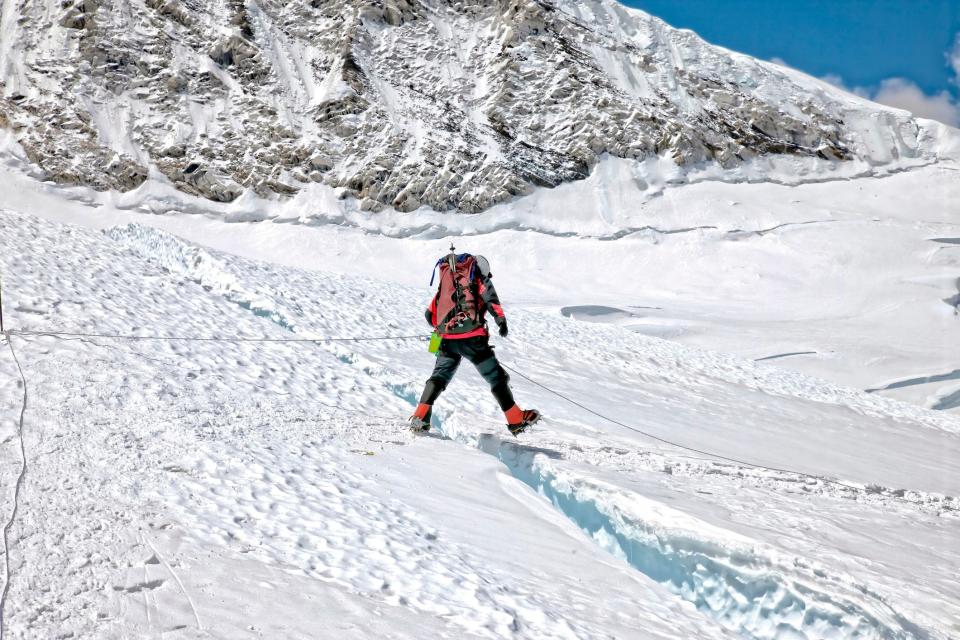-
The 2024 Mount Everest climbing season has been postponed due to the breakup of ice on the Khumbu Glacier.
-
Khumbu Icefall is one of the most dangerous obstacles to overcome on the way to the top of Everest.
-
As global temperatures increase due to climate change, these ice showers will become even more dangerous.
Climbing Mount Everest is a dangerous endeavor from the start. Climbers ascending to the top via the South Col route must face one of the deadliest passes before reaching Camp 1. Called the Khumbu Icefall, 2.6 miles of slowly flowing ice just above Base Camp.
It’s a treacherous labyrinth of crevasses that extend up to 300 meters deep and features house-sized “ice towers” that can break loose unexpectedly, triggering deadly avalanches like the one that killed three Sherpas last year.

It’s called an icefall because it looks like a frozen waterfall, but here on Everest, the term “fall” can be a serious warning to anyone. As of 2016, six people fell to their deaths, and this is only a small fraction of the total lives lost in the Khumbu.
This icefall is so dangerous that a special team of expert workers is responsible for charting a safe route through this icefall. They’re called the Icefall Doctors, and this year they postponed Everest’s climbing season by 12 days due to unsafe conditions at the Khumbu Icefall.
The situation will become even more dangerous as global temperatures rise, Paul Mayewski, a Mount Everest researcher and climate scientist at the University of Maine, told Business Insider. It explores how climate change is affecting the highest peaks on our planet.
What makes the Khumbu Icefall so dangerous?


The Khumbu Glacier is actually a slow-moving river of ice that gradually moves down the mountain as the Khumbu Glacier recedes.
Its movement is what makes it so unstable, leading to deep crevasses and deadly avalanches.
Between 1953 and 2019, 45 people lost their lives at the Khumbu Icefall. According to Alan Arnette, a climbing coach and summiteer of Mount Everest, the three main causes of death were icefall avalanches (49% of deaths), icefall collapse (33%), and falling into a crevasse (13%). blog about the mountain.
At the beginning of each climbing season, Icefall Doctors are the first to cross this dangerous icefall. They find the safest route by laying ropes and ladders along the way to help people navigate cliffs and crevices.
This year, the Icefall Doctors repeatedly encountered dangers that slowed down their process. According to outside news, inadequate snowfall and high temperatures in the winter destabilized the ice towers and bridges, forcing them to re-evaluate their routes several times.
“Going up there part of the day and coming down the next day can look very different. And that’s more likely to get worse with a warmer climate,” Mayewski said. said.
Climate change affects the Khumbu Glacier


Rapid melting causes glaciers such as the Khumbu Glacier to shrink and erode. This leads to more lakes and streams, but also increases the risk of more dangerous avalanches, ice falls and crevasses, Mayewski said.
“This situation is more likely to get worse in a warmer climate as the ice becomes more mobile,” he said. “The warmer the air, the more the water flows. And the flowing water obviously destabilizes the ice.”
Mayewski’s research suggests that conditions are changing not just in this region, but throughout Mount Everest. His study of Everest’s highest glacier, the South Col, found that one-third of its ice had disappeared in the last two to three decades.
“Just walking around base camp, it’s obvious there’s a lot of melting going on,” he said.
These are not the only dangers


Arnette points out that while it’s clear that climate change is making conditions on the Khumbu Glacier more dangerous, not all risks on Mount Everest are climate-related.
In 2023, the deadliest climbing year in Mount Everset history, 15 of the 18 total deaths were caused by acute mountain sickness, falls and disappearances. He thinks most of these deaths were probably preventable.
For example, acute mountain sickness, a mild form of altitude sickness, can be treated if climbers and their guides recognize symptoms quickly and descend to lower altitudes, Arnette said. But if the climbers choose to continue, their condition could be fatal. AMS claimed eight deaths on Everest last year, according to the Himalayan Database.
Arnette believes implementing more safety practices on the mountain would go a long way in reducing fatalities.
Climbers sometimes also put themselves at risk by choosing low-cost operators, climbing Everest without sufficient climbing experience, or refusing to return even if they show signs of illness. In this last case, Sherpas often have difficulty convincing their clients to throw in the towel due to language and cultural barriers, Arnette said.
Will the additional risks posed by climate change one day make climbing Everest impossible? Mayewski doesn’t think so.
“Will people still be able to do it? Yes, I think they will. Will it be more dangerous? Probably yes, it’s already quite dangerous,” he said.
Read the original article on Business Insider